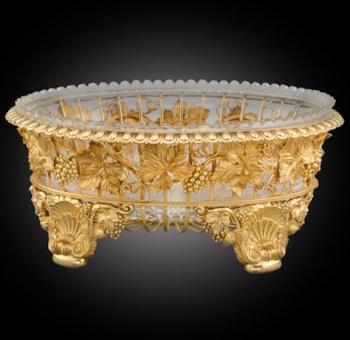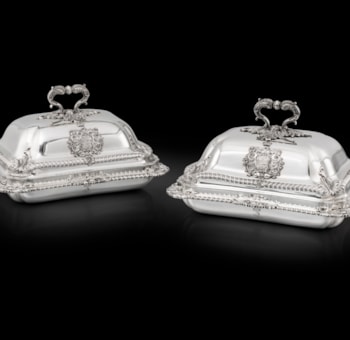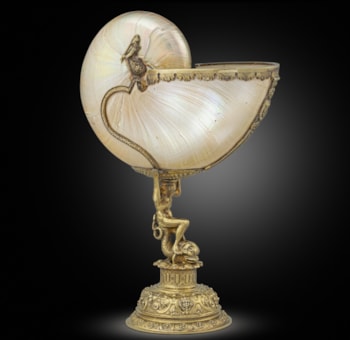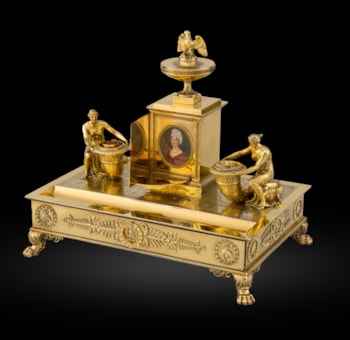Leslie Gorden Durbin
( 1913 - 2005 )
He started his training as a silversmith when he was only 13 years of age. Three years later he became apprenticed to Omar Ramsden, the leading silver designer of the day. His apprenticeship over he stayed on for a couple of years before obtaining a scholarship when he was in his mid-20s to study at the Central School of Arts. He graduated in the year that World War II began, but from the very beginning he received prestigious commissions. Throughout the 1950s and in the early 1960s he was the UK’s best-known silversmith. Leslie Gordon Durbin was born in Fulham, London in 1913. His father died in the Spanish Flu Epidemic of 1918 and his mother and her two children went to live with her parents. In 1926 aged 13 years, Leslie obtained a London County Council Trade Scholarship and studied silversmithing at the Central School of Arts and Crafts (CSAC). He continued his normal school lessons in the morning and went to study at the CSAC in the afternoons. When his education finished in 1929 he was recommended to Omar Ramsden, who duly took on Leslie as an apprentice. However, much to young Durbin’s horror, he was apprenticed as a ‘chaser, engraver and decorator of precious metals’, while he in fact wanted general silversmith training, so he continued with night school at the CSAC. His apprenticeship over, he remained with Ramsden for another couple of years, but in 1938 won a Worshipful Company of Goldsmiths’ (the Company’s) scholarship for a year at the CSAC. While one suspects that life had been difficult for Leslie, matters now changed. He entered a competition to design the plate for the Chapel of Chivalry in Guildford Cathedral and won. Durbin made the pieces together with five colleagues and tutors at the CSAC and the finished pieces were exhibited at the Company’s Exhibition of Modern Silverware at Goldsmiths’ Hall. Incidentally, this was the first exhibition of contemporary silver staged by the Company. It was to be visited by Queen Mary and the Company proposed a gift for her 12-year-old granddaughter Princess Elizabeth to be presented to the Queen. Reginald Hill, who had won the Company’s Travel Scholarship in 1937 and Leslie Durbin were asked to submit designs. Durbin’s design won, but his design of a casket with a finial in the form of gambolling lambs to symbolise its recipient being in ‘the spring-time’ of life was executed as a joint collaboration between Hill and Durbin so as to meet its delivery deadline. In 1939 Leslie won a Travel Scholarship from the Company, but his tour had to be cut short because of the threat of war. Furthermore, the Company was going to sponsor his visit to the New York World Fair later in the year, but that too was cancelled. Upon his return he was asked to make a dish for presentation to HM King George VI and HM Queen Elizabeth by Sir Stephen and Lady Courtauld to commemorate the Royal couple’s State visit to Canada during that summer. He received this commission because a liveryman of the Company, E Alfred Jones, was keen to promote up-and-coming young silversmiths. The Company’s then Clerk, George Hughes, introduced him to Leslie Durbin and Jones in turn introduced him to the Courtauld’s at their splendid Art Deco mansion adjacent to the great Hall of the medieval Eltham Palace in southeast London. Leslie felt very much out of place at the luncheon party and turned down the offer of an outhouse at Eltham from which to work. Instead he appealed to Francis Adam, his tutor at the CSAC who gave him the use of his garden shed workshop at his Lambeth home. It has been said that the Courtaulds’ Royal commission resulted in Leslie’s call-up for war service being delayed. However, the Royal dish was hallmarked 1939 which does not explain why Leslie did not report to the RAF until December 3rd 1941. Up until then he seems to have been generally kept very busy with very important institutional commissions and once those were completed, with private ones. Indeed, we know of one Leslie Durbin design made in 1942 while he was in the RAF by Francis Adam and Emerson Hammond, another tutor at the CSAC. Leslie was soon transferred, like Alex Styles, to the Modelmakers’ Section of the Central Interpretation Unit. Although displeased that his late call-up meant there was no leave for six months, it was not long before the young Leslie Durbin had been offered an opportunity that brought him very much to the public eye and indefinite leaf from the forces. To commemorate the heroic stance made by the citizen’s of Stalingrad during the besieging of their city by the Germans (over a million citizens had lost their lives before the besiegers surrendered), it was decided that they should be presented with the Sword of Honour for Stalingrad. Following a limited competition organised by the Company, King George VI selected the design of R M Y Gleadowe. Wakely and Wheeler, who usually executed Gleadowe’s designs, was asked to make the piece, but declined as they were engaged with war work. However, Arthur Wakely asked Leslie to make it and he agreed to undertake the gold and silver components. Although the Germans surrendered on February 2nd, the Foreign Office made no announced regarding the sword until June. British Paramount filmed the making process and the public’s imagination was captivated by the painstaking efforts of the craftsmen at work seen during their cinema visits. Before it was presented to Marshall Stalin on November 24th, the sword was put on exhibition in London and a further 15 British cities for one day only. People queued to see it – an estimated 30,000 people in each location, making a total of nearly half a million. No wonder it was described as the most high profile British sword since Excalibur. After the War Leslie Durbin went into partnership with Len Moss, his senior at Ramsden’s, who was known as ‘an artist with a hammer’. Their workshop was established at 62 Rochester Place in northwest London. Following Leslie’s exposure with the Sword of Stalingrad and his early commissions, it is not surprising that there was no shortage of work. Furthermore, Ramsden had died and his widow pointed work in the direction of her husband’s former apprentices. In the introduction to Leslie Durbin’s retrospective catalogue at Goldsmiths’ Hall in the summer of 1982, Susan Hare, the then Librarian of the Company wrote, ‘Leslie Durbin’s designs in the early 1950s were like a breath of spring air in their innovative quality, while still retaining a strong feeling for the symbolic.’ Leslie was a superb modeller and a characteristic of his work was the incorporation of birds and animals into his work. He was a frequent visitor to London Zoo. Mrs Ramsden also sold him the casts for his models and these too incorporated into some of his work. The quality of Durbin’s output was always of the highest standard, with the majority of the work being handraised. A high profile piece to emerge from the workshop in the early 1950s, was the Festival of Britain Tea Service to be used by the King and Queen and other dignitaries at the Festival’s Royal Pavilion. Designed by Robert Gooden, it is of superb craftsmanship but of questionable design. With regard to the normal output from the workshop, Leslie sought the commissions, designed the pieces, undertook the modelling and worked at the bench. Despite the output with a relatively small team he also managed to teach. Initially he taught at the CSAC from 1946 and then at the Royal College of Art, where he continued until the mid-1950s. He therefore encountered Gerald Benney, David Mellor and Robert Welch as students. Although Len Moss retired in 1970, Leslie continued working at Rochester Place. The workshop was purchased by Hector Miller in 1975 and after a short overlap Leslie moved to a new workshop in the garden of his Kew home. There he continued to work at his own pace on projects that interested him. Some of these were high profile, such as the modelling of the Queen’s head for the special 1977 Jubilee Mark; from 1984-7, designing the reverses for the regional £1 coins (these were repeated from 1989-92) and in 1994 the reverse of the £2 commemorating the 350th anniversary of the founding of the Bank of England. One of his last commissions was to design a silver spoon for the Clothworkers’ Company to commemorate the millennium. Leslie Durbin died on 24 February 2005 aged 92. He was working well into his 80s.


































































